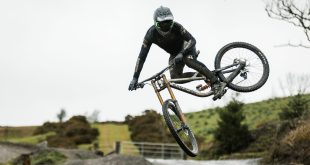There’s a perrenial thought that rolls around each year, every year, like clockwork; that this year we will find the one true mountain bike. The one bike to rule them all: that rides uphill faster than a mountain goat; that descends faster than Greg Minaar; that roosts sinuous and gnarly singletrack with equal aplomb and does it all without a moment’s hesitation or excess puppy fat.
But let’s be frank: this kind of hyperbole is just that: hyperbole. No bike will ever do everything well: a 3.5in travel bike will never descend as well as a World Cup downhill rig, and likewise, a downhill rig will never climb as well as a whippet XC bike. Okay, they’re extreme examples but what they do highlight is that bikes are inevitably built as compromises. Trail bikes are the jack-of-all-trades, master-of- none, and will be beaten uphill by short-travel XC rocket ships, and down by more gravity-focused machinery.
Yet they’re the staple trail rider’s steed, what most folks’ are riding (or aspiring to ride): they’ll climb better than a DH bike ever will, and descend more confidently than an XC race bike. And it’s worth nothing that as you move to a lighter XC extreme or to a more burly downhill one, the relative compromises of these bikes are merely shifted.
But year-on-year bikes are getting better as materials and manufacturing technologies dovetail with advances in suspension, components, tyre technologies, and so forth. The result is that, although bikes are still compromises, the range of compromise is being reduced incrementally year-on-year so that bikes are now better in more situations than their predecessors were.
Today things are most definitely better than ever as the refocus of many brands on shorter travel bikes in the 100mm range has meant significant drops in weight, and optimised geometry and suspension quality (22lb, £2000, 100mm XC full-suss bikes that genuinely are trail assured, anyone?). The upshot is that the window of compromise has undoubtedly been significantly reduced. Materials have played their part, but, for real riders, with real pockets, the £4,000 carbon superbikes remain top-shelf wet dreams. What are genuinely important are the £1,000 to £2,000 bikes: the ones that most riders will actually be riding out there.
This was brought home specifically when we were in the Lakes on our Bike of the Year shootout as we seem to have finally reached a true watershed: where the compromises made on bikes are almost negligible, so much so that the best of today’s 4in travel lightweight XC full-sussers can truly take on virtually everything the trail has to offer, climbing and descending as voraciously as is possible. The limiting factor now is the rider baulking at the terrain, not the bike, which is just as it should be.
Which brings us full circle to the days of yore when we raced one bike up, down and along, without even an idea of specialist downhill or XC bikes.
That bike was the mountain bike. Today, we may have just seen it return. At last.
 BikeBiz Bicycle and cycling retail news
BikeBiz Bicycle and cycling retail news



